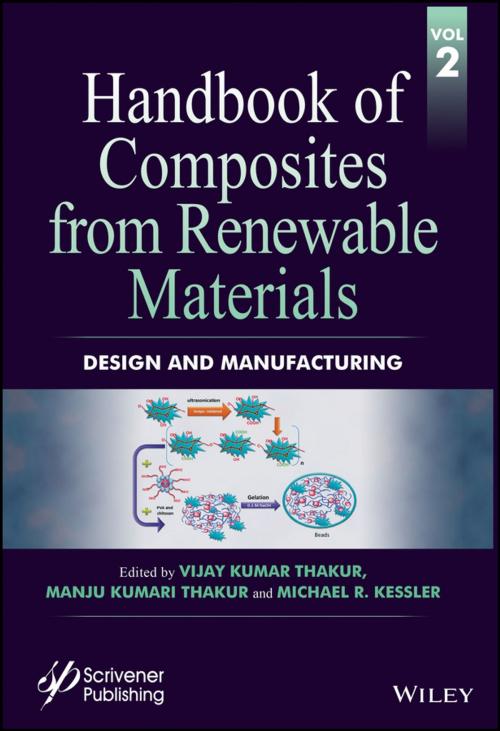Handbook of Composites from Renewable Materials, Design and Manufacturing
Nonfiction, Science & Nature, Technology, Engineering, Chemical & Biochemical| Author: | ISBN: | 9781119224273 | |
| Publisher: | Wiley | Publication: | February 17, 2017 |
| Imprint: | Wiley-Scrivener | Language: | English |
| Author: | |
| ISBN: | 9781119224273 |
| Publisher: | Wiley |
| Publication: | February 17, 2017 |
| Imprint: | Wiley-Scrivener |
| Language: | English |
The Handbook of Composites From Renewable Materials comprises a set of 8 individual volumes that brings an interdisciplinary perspective to accomplish a more detailed understanding of the interplay between the synthesis, structure, characterization, processing, applications and performance of these advanced materials. The handbook covers a multitude of natural polymers/ reinforcement/ fillers and biodegradable materials. Together, the 8 volumes total at least 5000 pages and offers a unique publication.
This 2nd volume of the Handbook is solely focused on the Design and Manufacturing of renewable materials. Some of the important topics include but not limited to: design and manufacturing of high performance green composites; manufacturing of high performance biomass-based polyesters by rheological approach; components design of fibrous composite materials; design and manufacturing of bio-based sandwich structures; design and manufacture of biodegradable products from renewable resources; manufacturing and characterization of quicklime filled metal alloy composites for single row deep groove ball bearing; manufacturing of composites from chicken feathers and poly (vinyl chloride); production of porous carbons from resorcinol-formaldehyde gels: applications; composites using agricultural wastes; manufacturing of rice wastes-based natural fiber polymer composites from thermosetting vs. thermoplastic matrices; thermoplastic polymeric composites; natural fiber reinforced PLA composites; rigid closed-cell PUR foams containing polyols derived from renewable resources; preparation and application of the composite from alginate; recent developments in biocomposites of bombyx mori silk fibroin; design and manufacturing of natural fiber/ synthetic fiber reinforced polymer hybrid composites; natural fibre composite strengthening solution for structural beam component for enhanced flexural strength; high pressure resin transfer molding of epoxy resins from renewable sources; cork based structural composites; the use of wheat straw as an agricultural waste in composites for semi-structural applications and design/ manufacturing of sustainable composites.
The Handbook of Composites From Renewable Materials comprises a set of 8 individual volumes that brings an interdisciplinary perspective to accomplish a more detailed understanding of the interplay between the synthesis, structure, characterization, processing, applications and performance of these advanced materials. The handbook covers a multitude of natural polymers/ reinforcement/ fillers and biodegradable materials. Together, the 8 volumes total at least 5000 pages and offers a unique publication.
This 2nd volume of the Handbook is solely focused on the Design and Manufacturing of renewable materials. Some of the important topics include but not limited to: design and manufacturing of high performance green composites; manufacturing of high performance biomass-based polyesters by rheological approach; components design of fibrous composite materials; design and manufacturing of bio-based sandwich structures; design and manufacture of biodegradable products from renewable resources; manufacturing and characterization of quicklime filled metal alloy composites for single row deep groove ball bearing; manufacturing of composites from chicken feathers and poly (vinyl chloride); production of porous carbons from resorcinol-formaldehyde gels: applications; composites using agricultural wastes; manufacturing of rice wastes-based natural fiber polymer composites from thermosetting vs. thermoplastic matrices; thermoplastic polymeric composites; natural fiber reinforced PLA composites; rigid closed-cell PUR foams containing polyols derived from renewable resources; preparation and application of the composite from alginate; recent developments in biocomposites of bombyx mori silk fibroin; design and manufacturing of natural fiber/ synthetic fiber reinforced polymer hybrid composites; natural fibre composite strengthening solution for structural beam component for enhanced flexural strength; high pressure resin transfer molding of epoxy resins from renewable sources; cork based structural composites; the use of wheat straw as an agricultural waste in composites for semi-structural applications and design/ manufacturing of sustainable composites.















